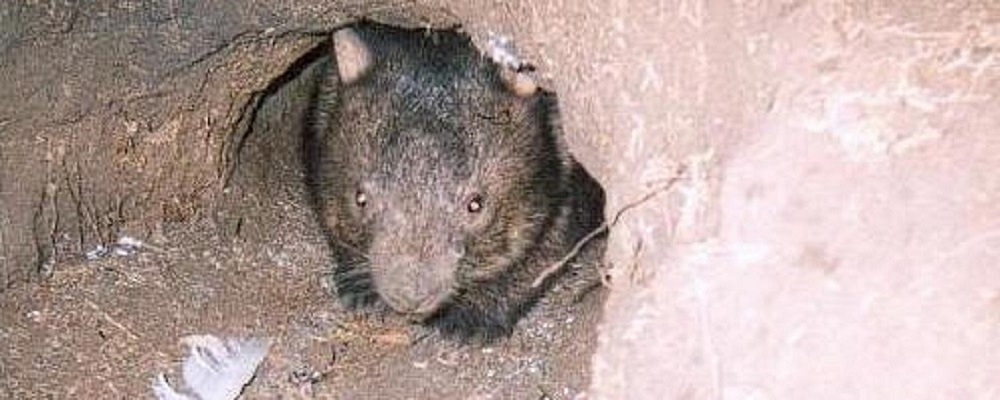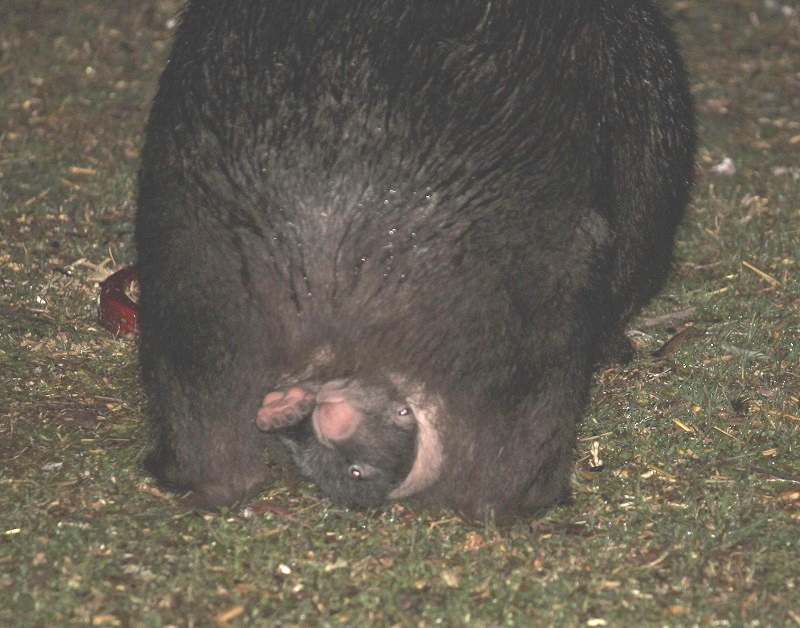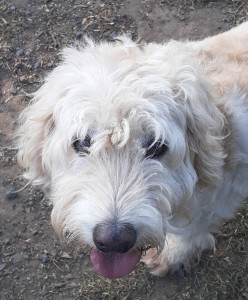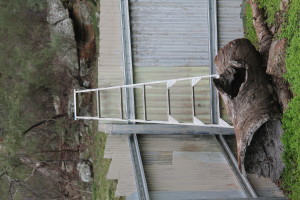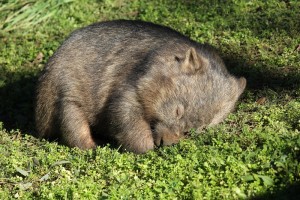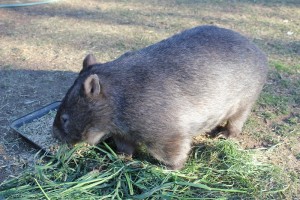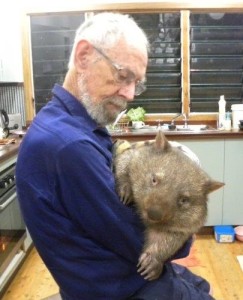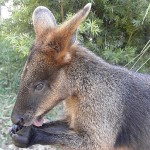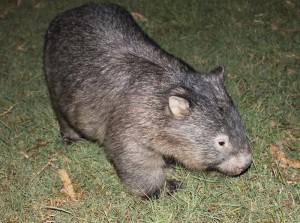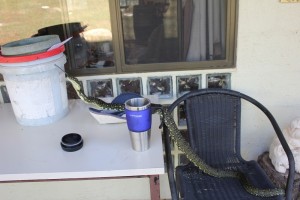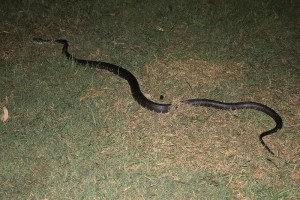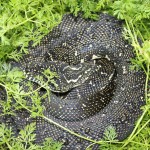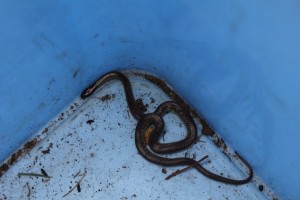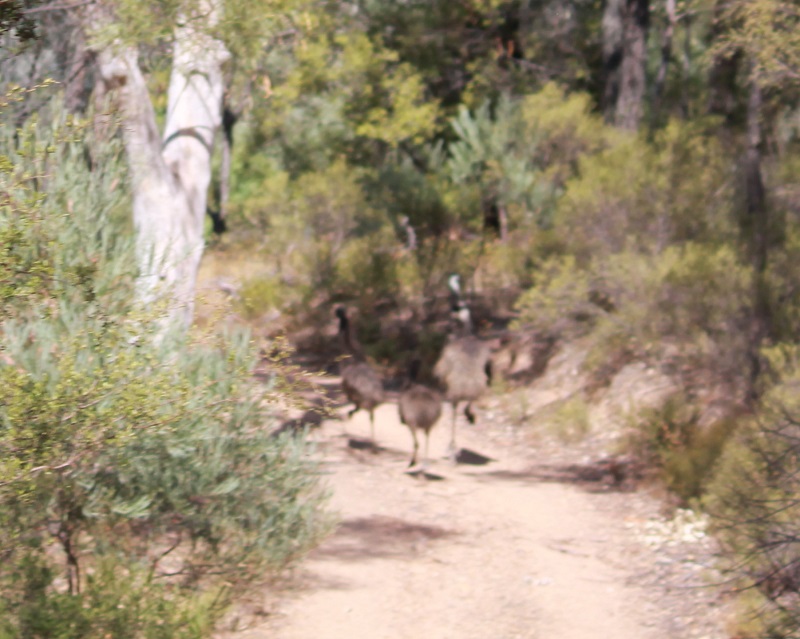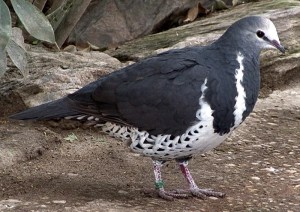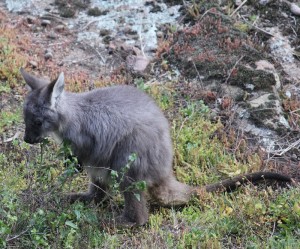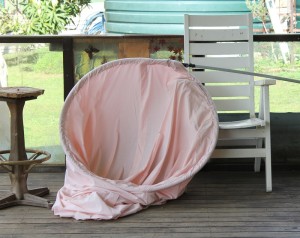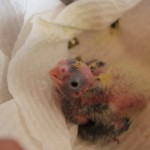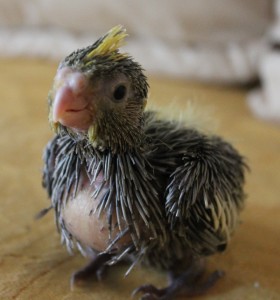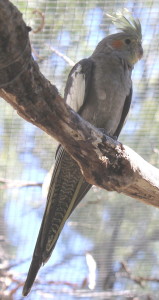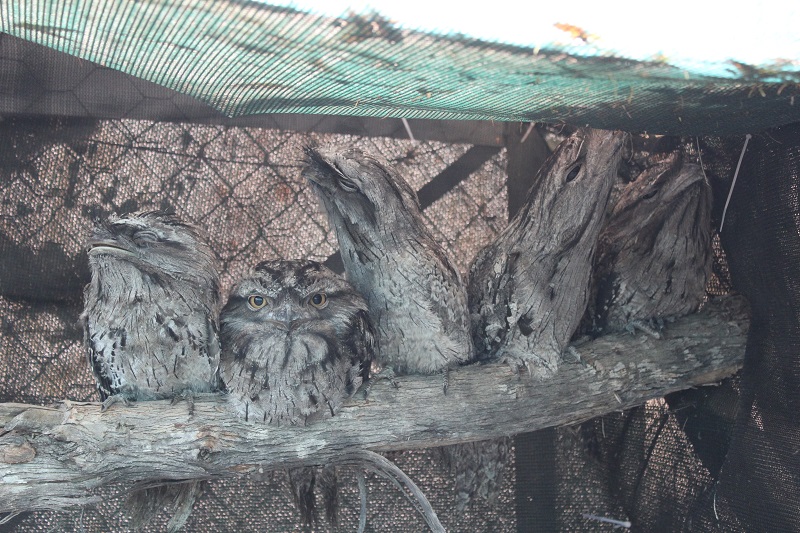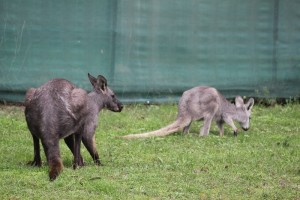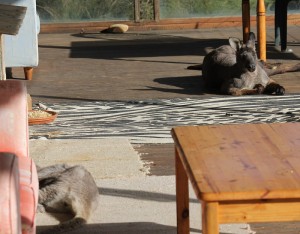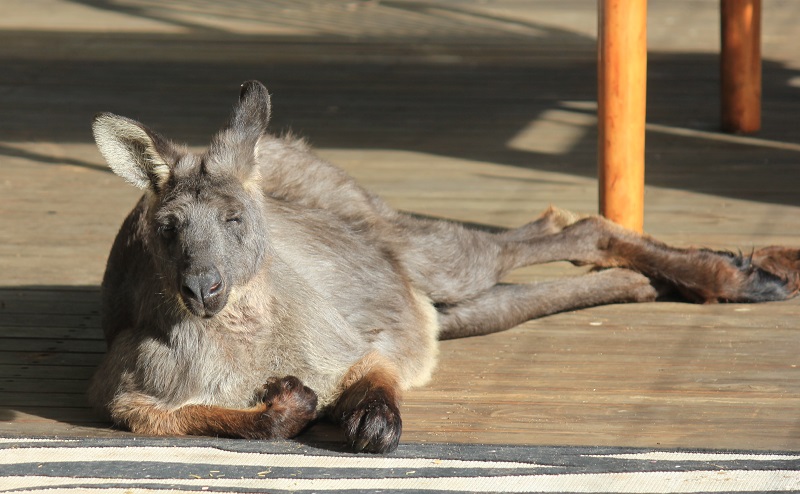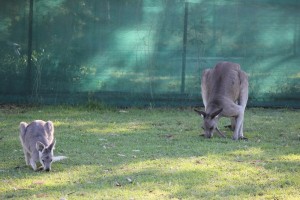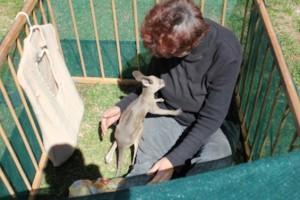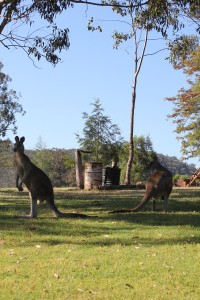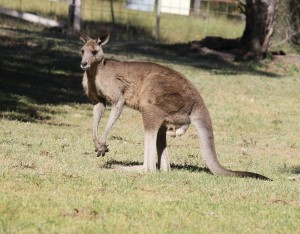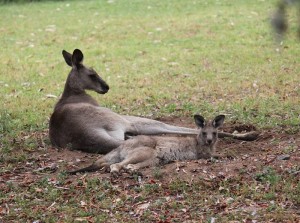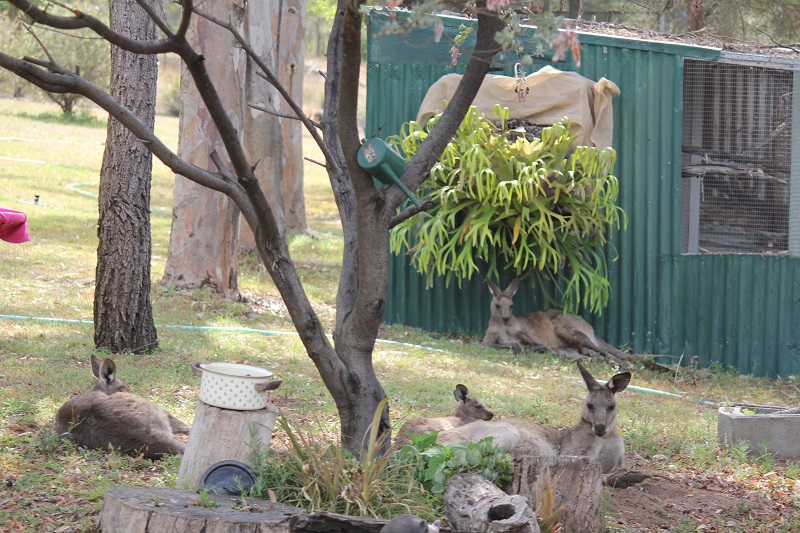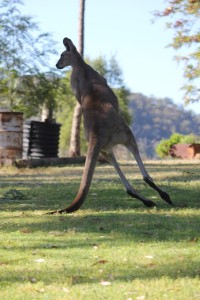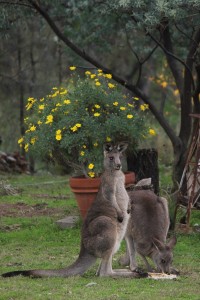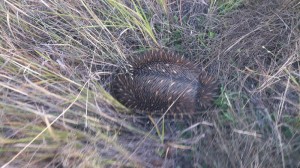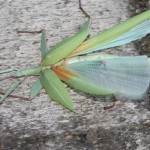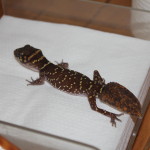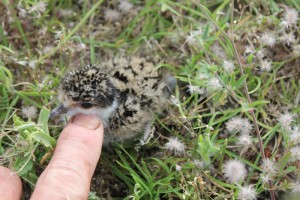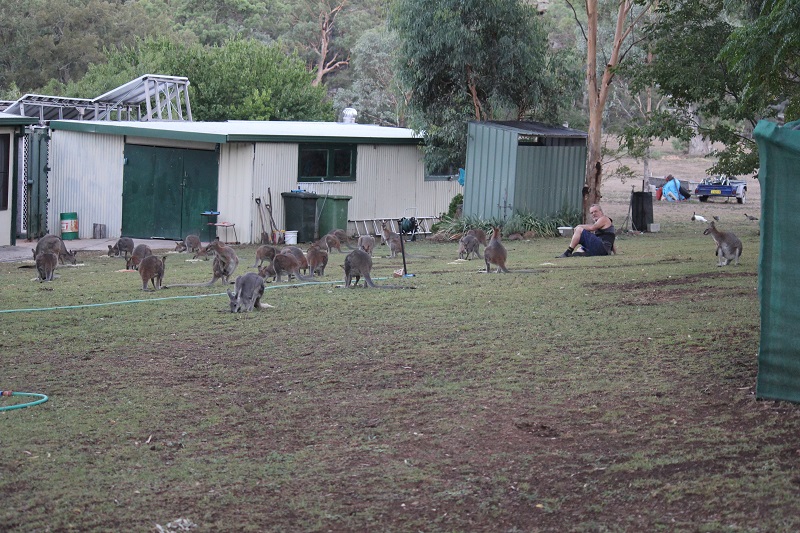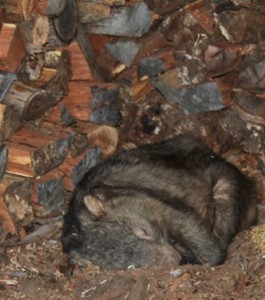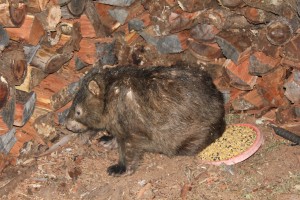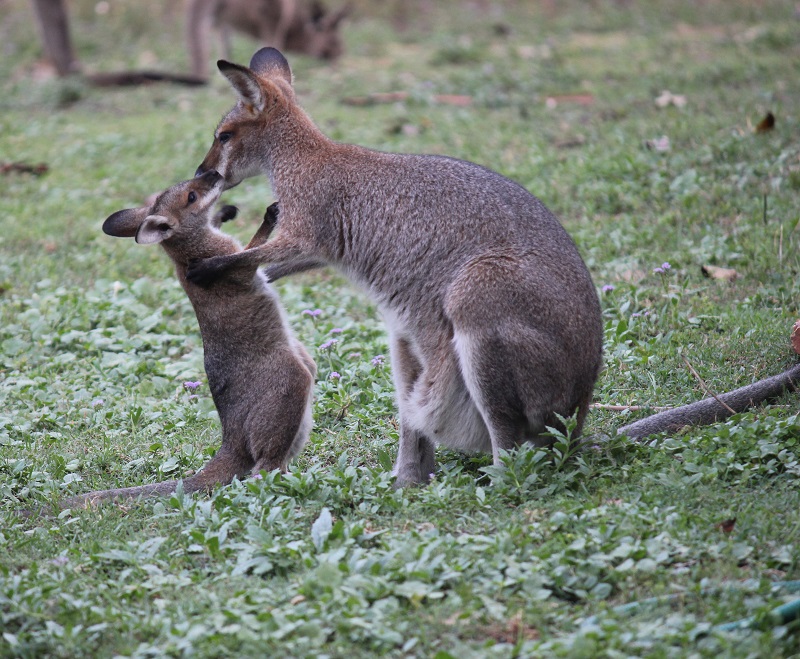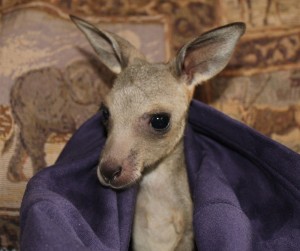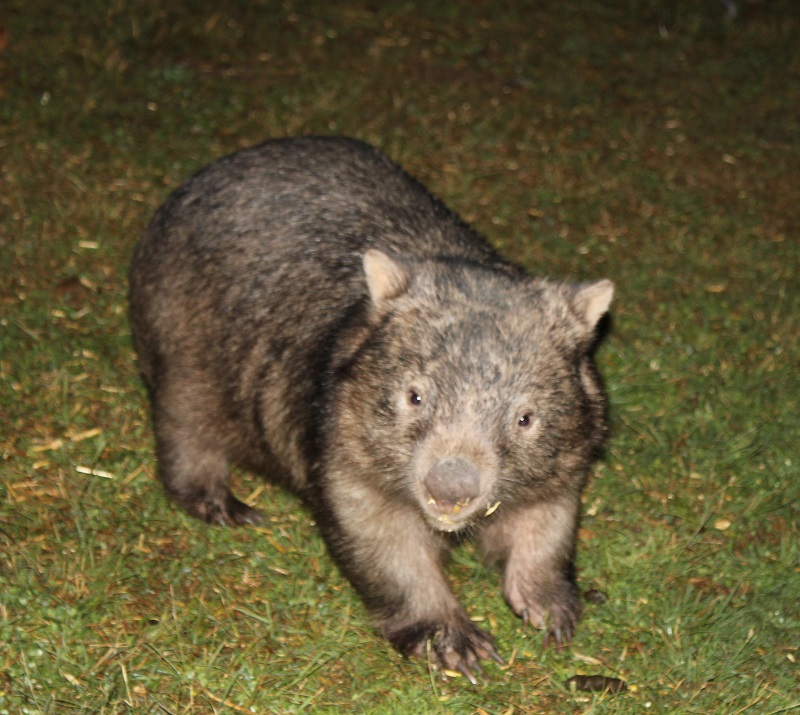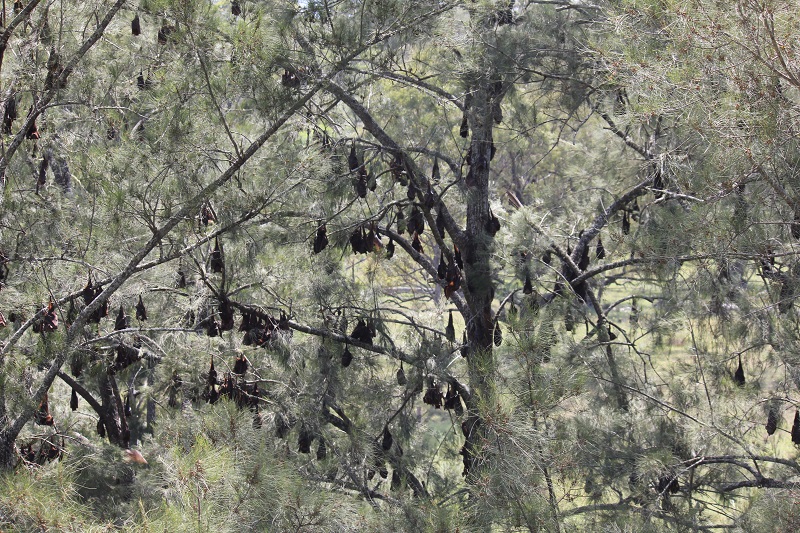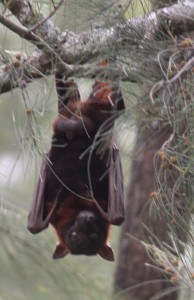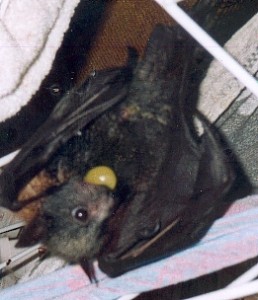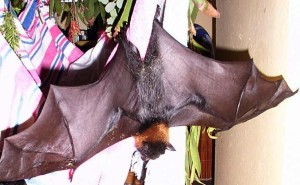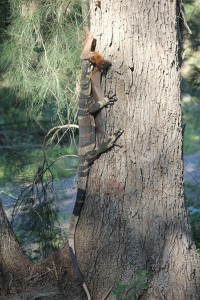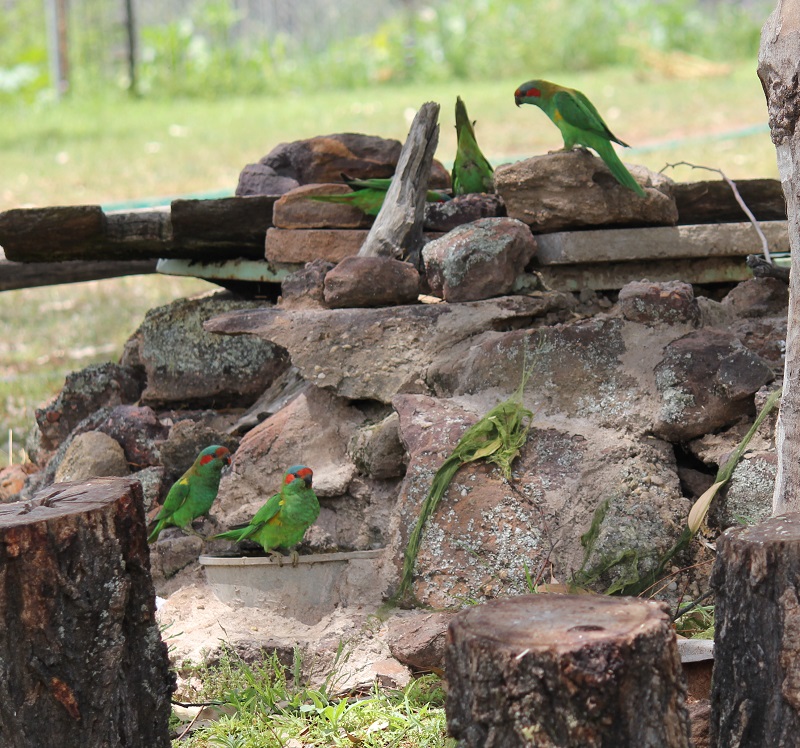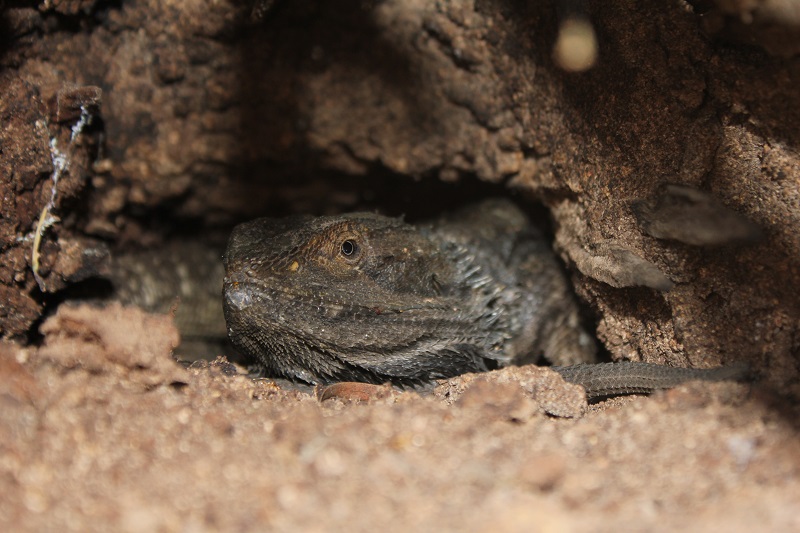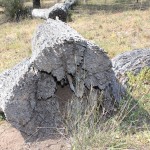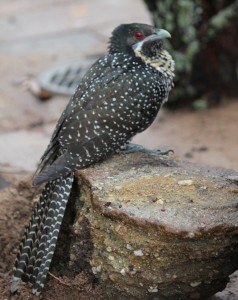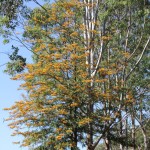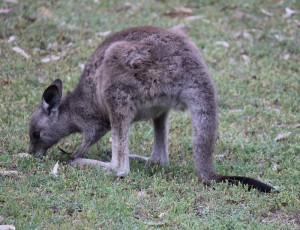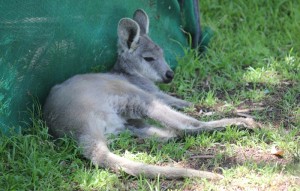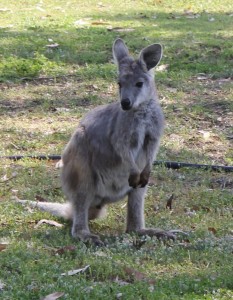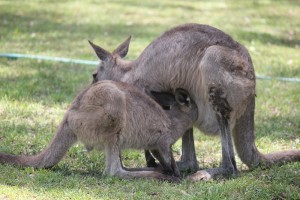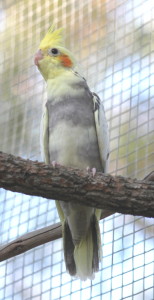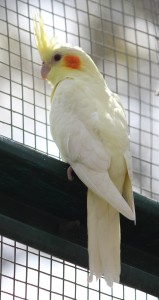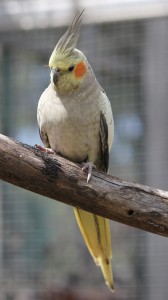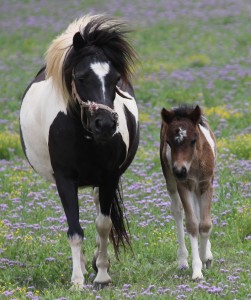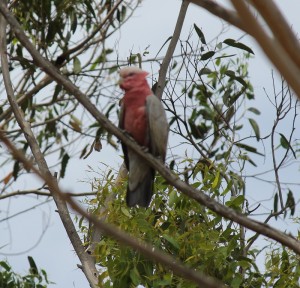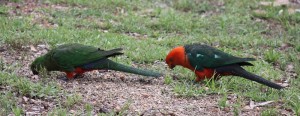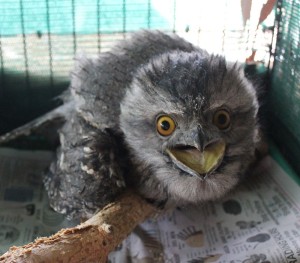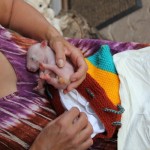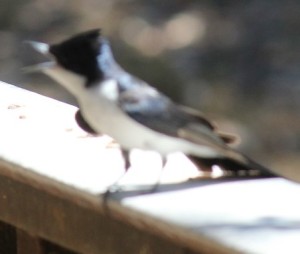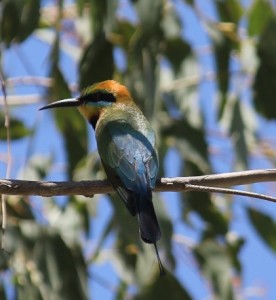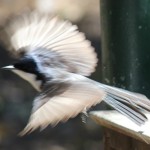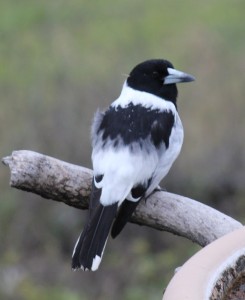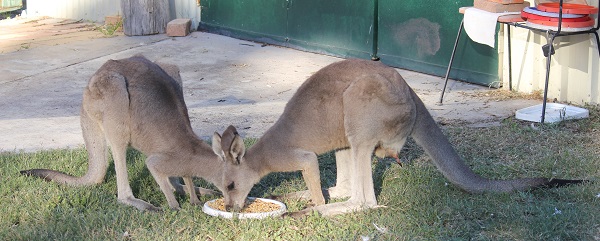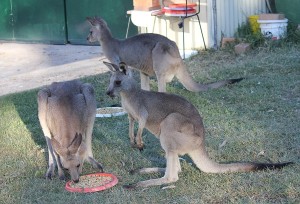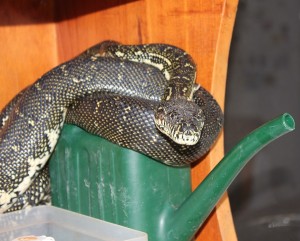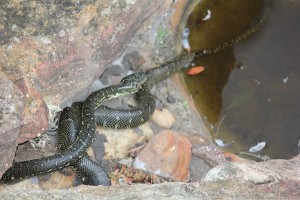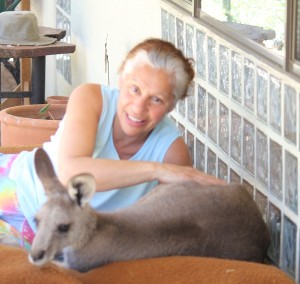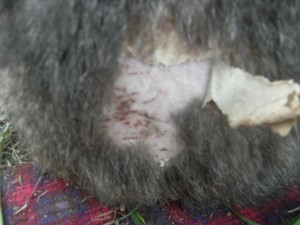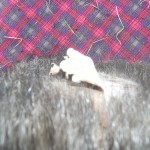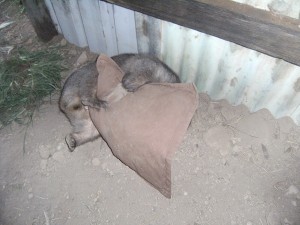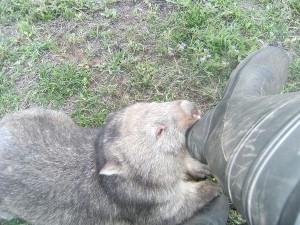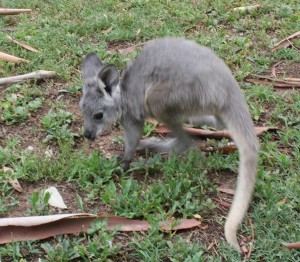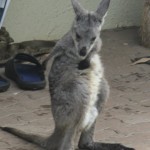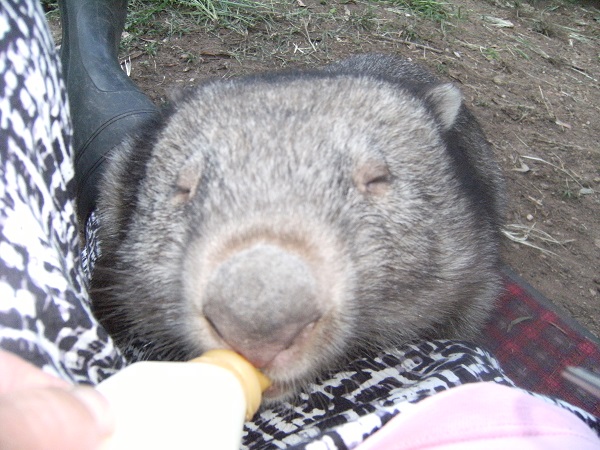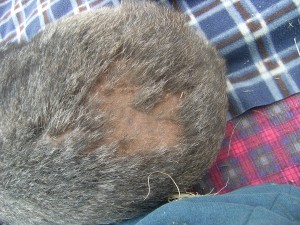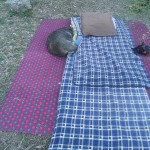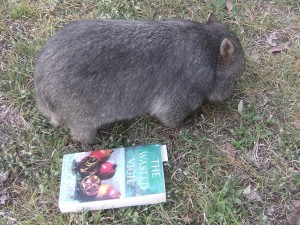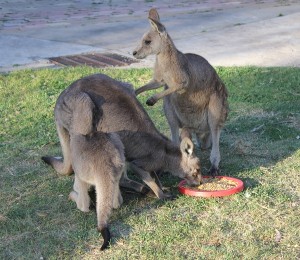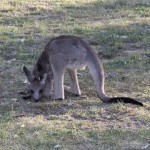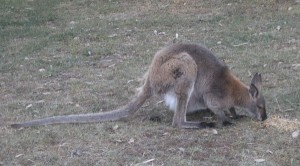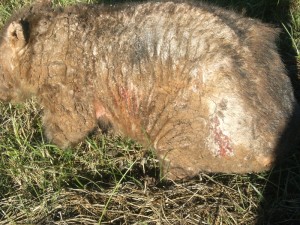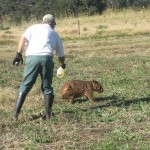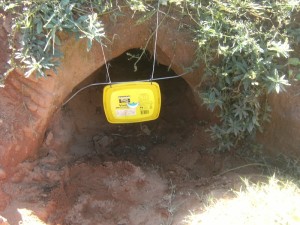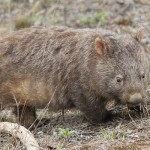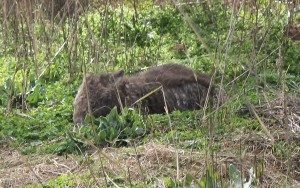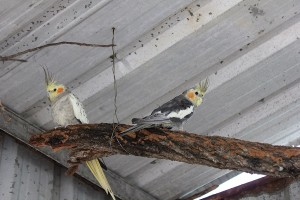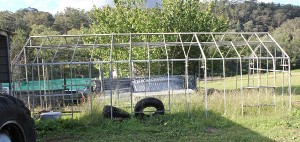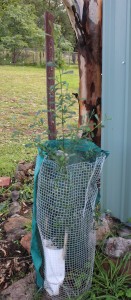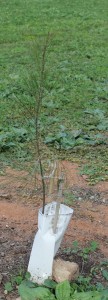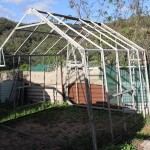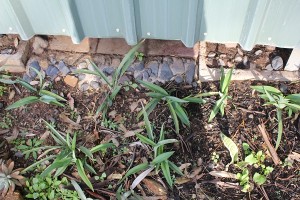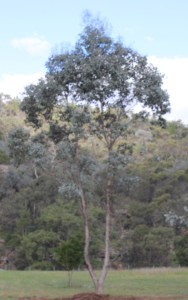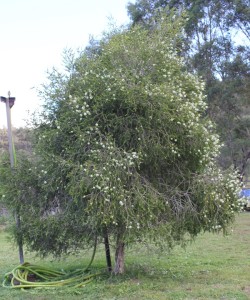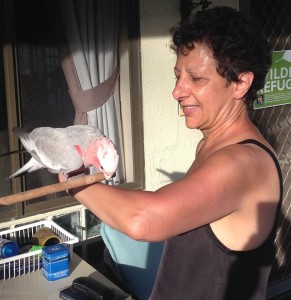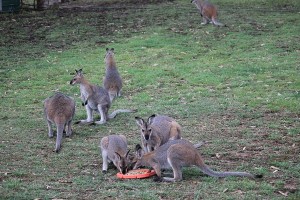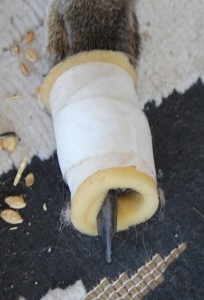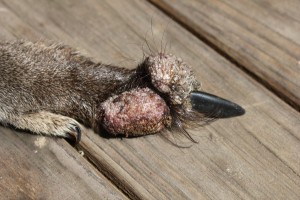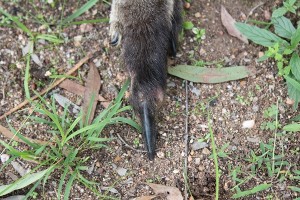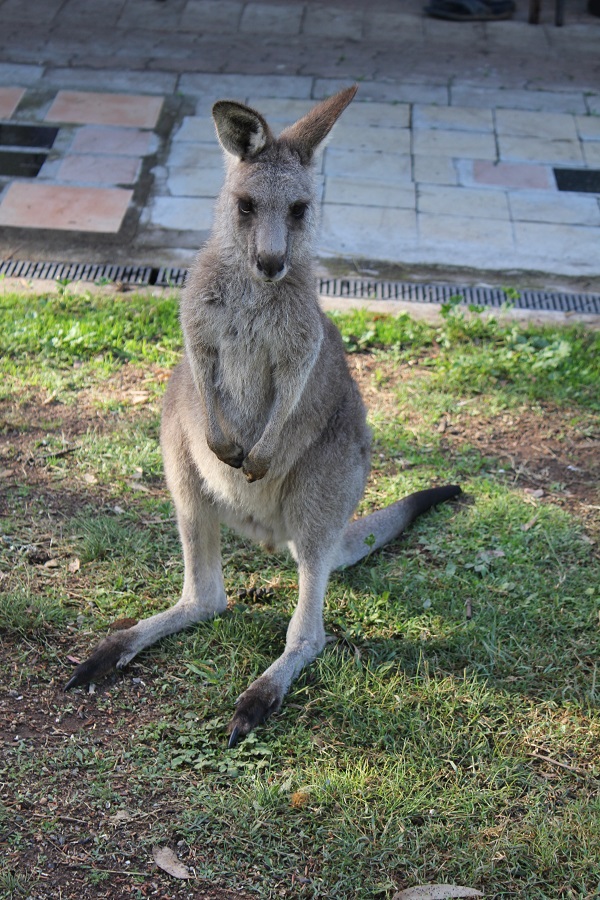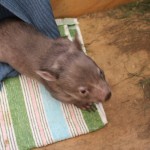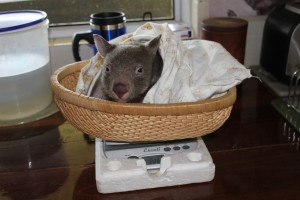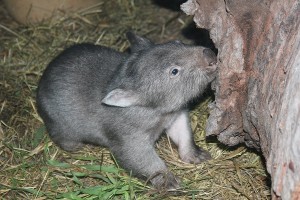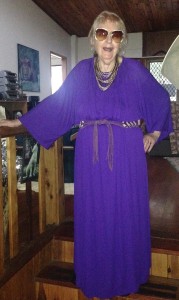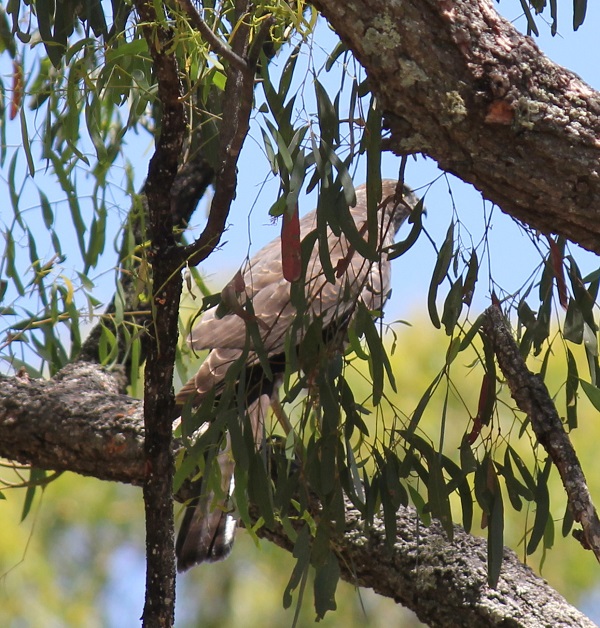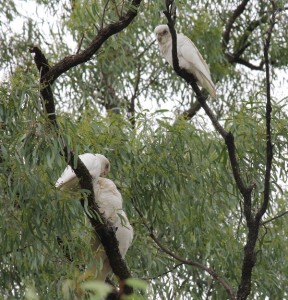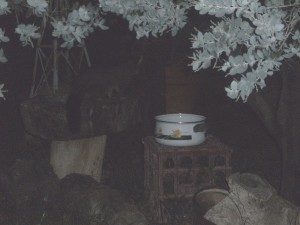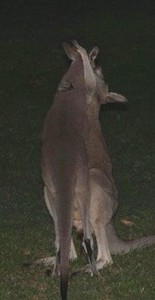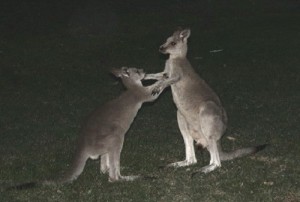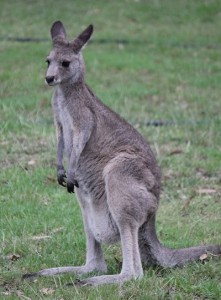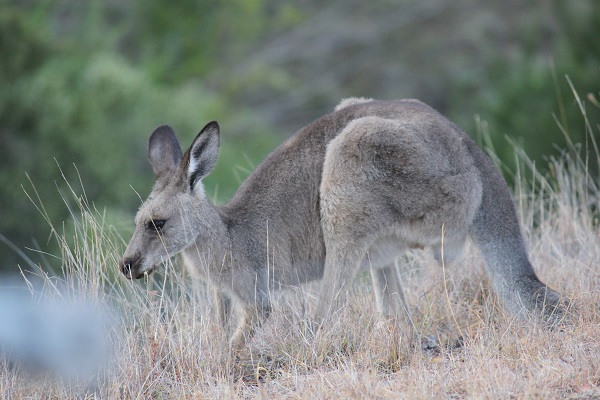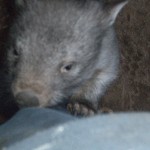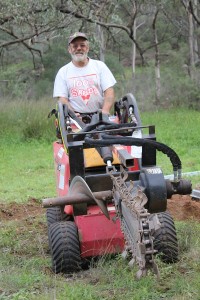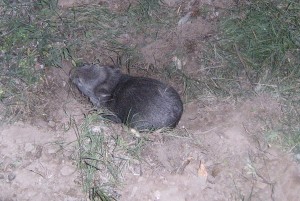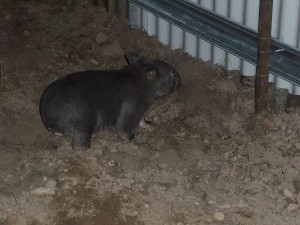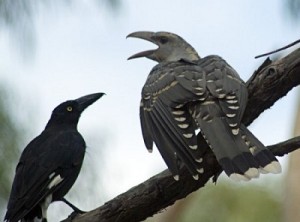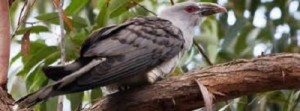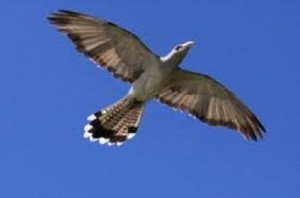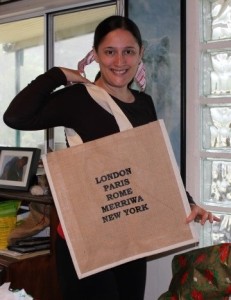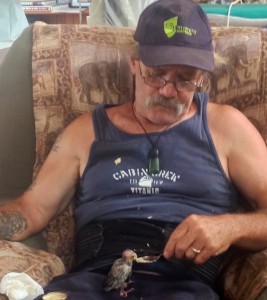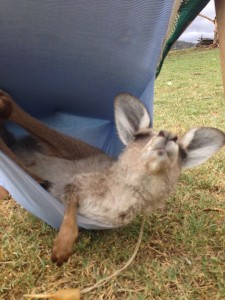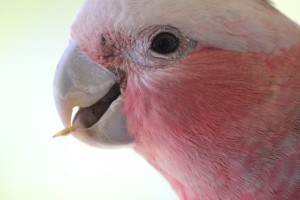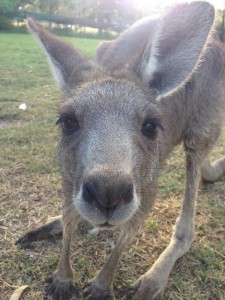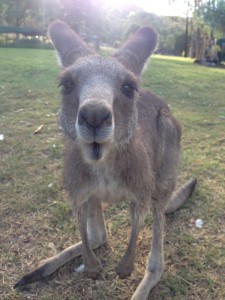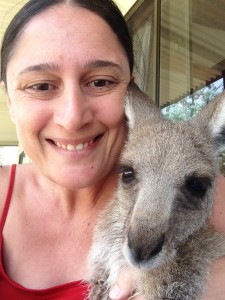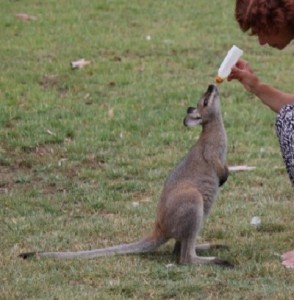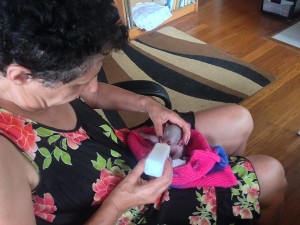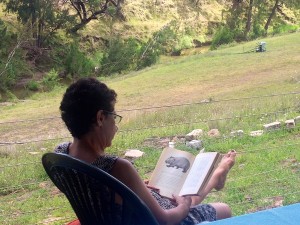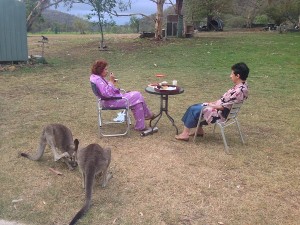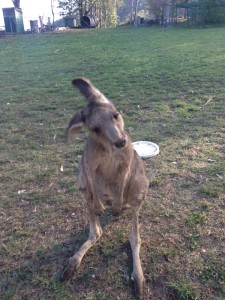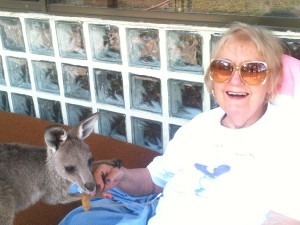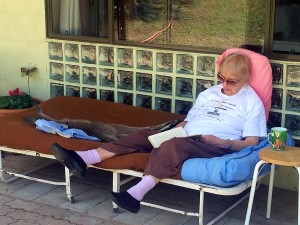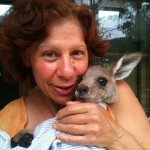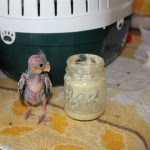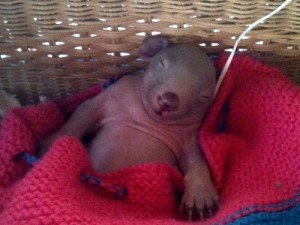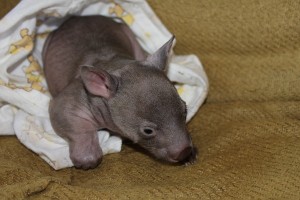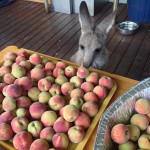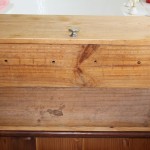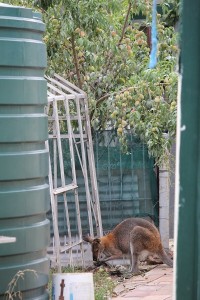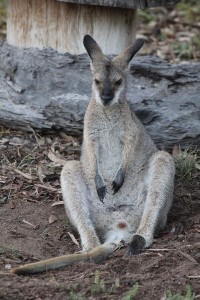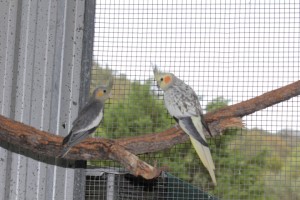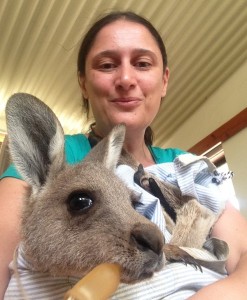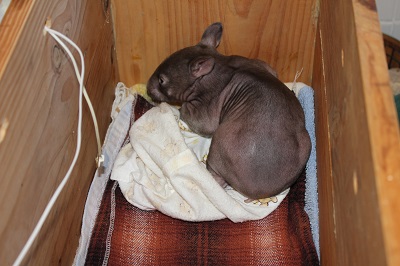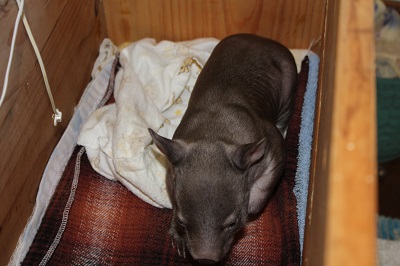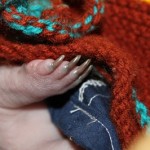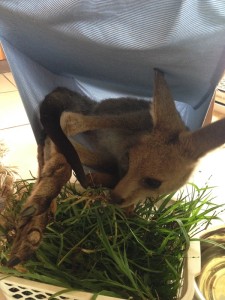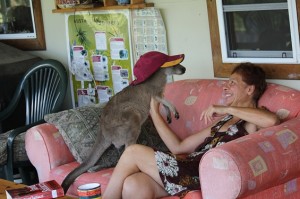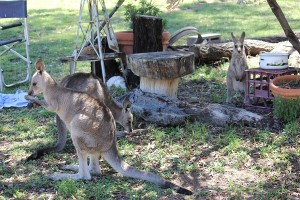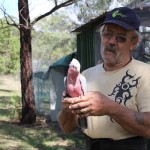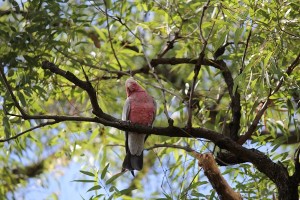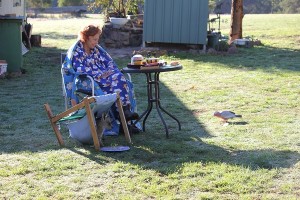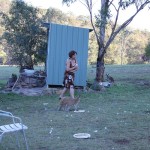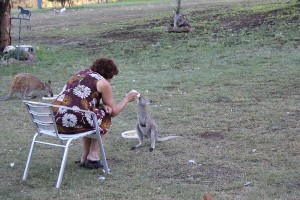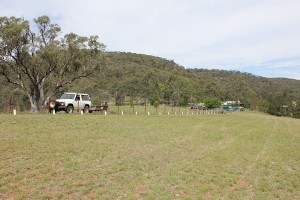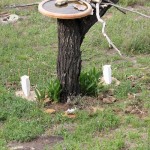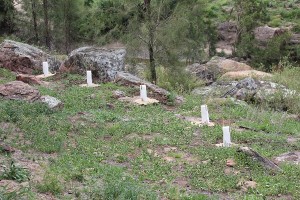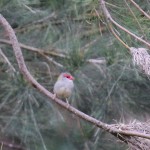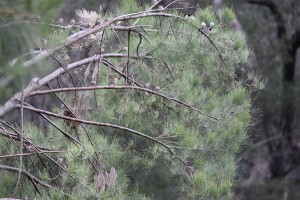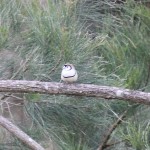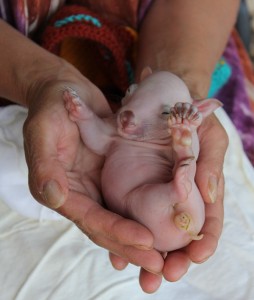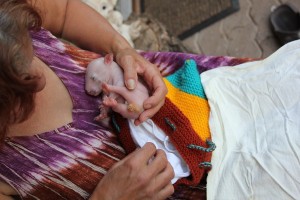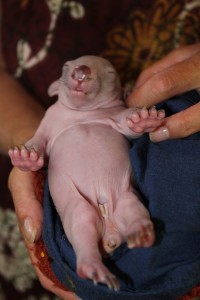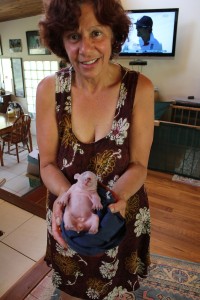It’s been months since I attempted to write an update. The time here passes so quickly. I’m not sure if it’s that line that older people can’t help saying to kids ” just wait till you get older and a year will seem like 5 minutes ” or am I just to occupied with being lay back ,answering my email ,doing a bit of raking, watching the wild life and reading! Britty keeps me outside in the paddock with the other wallaroos from about 1.30 pm – 5.00pm so reading is a very good option as movement and noise scares them off. Good for the mind but bad for the middle age spreading behind! I had been sleeping outside for about 3 weeks as it was time to get Britty grazing in the paddock at night.I was driven back in by the big buffoon “Fidel”. I was just getting into bed about 11pm one night when I noticed a wombat about Fidel’s size in the centre of the paddock. There have been 3 coming at different times .Fidel would often turn up at dusk when the grain goes out for the macropods ,have a nibble then go off. About 11.00pm another about his size would turn up ,nibble then go off .Early hours of the morning I would often be woken by loud crunching and it would be a very large wombat eating grass .I thought the wombat that night was the regular when I suddenly saw the nose go up and sniff the air. Next thing Fidel had launched himself up into my bed . Sleeping with him is not a pleasure , when he was small and cuddly in his bag it was O.K. Now he bites hard and has a distinct wombat smell which I don’t actually find unpleasant but it wouldn’t be good to go about smelling like a wombat. Since then he has decided that a kip in that bed is a good idea at what ever hour he chooses so I have had to give up my night viewing for now. The time out there was long enough to get Britty brave enough to go out the front on her own for sort bursts of time so that’s O.K. I had the bed folded up and he would appear in there at different times .I know he has different burrows as well as I managed to follow him a couple of times so he must treat the bed as a rest burrow that he knows won’t have any other wombat in it. Since his release in January he has been attacked twice and had a big patch on his rump plus a bald forehead .
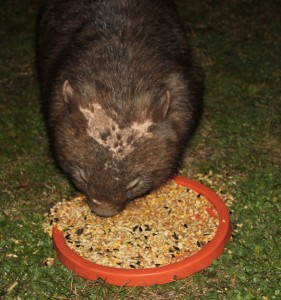
forehead attack
The fur is now growing back and he’s not looking so much like an old threadbare carpet so I was quite pleased he could hide away in the folded bed if he wanted to while the fur grew back. The past couple of months has been great for observing wombats as they are out during the day in the cool temperatures . Just around the 3 house paddocks we have seen 3 mothers with babies and many adults .
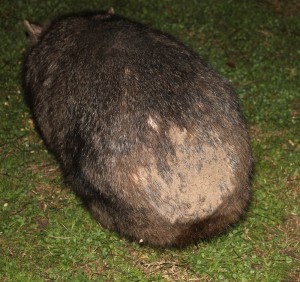
butt Attack
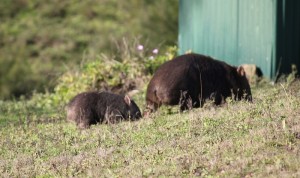
mum & baby grazing
Most of them are healthy. Larry has been treating the wombats that have mange for quite some time now between our place and 3 properties before here. When we do see one with some mange we start the treatment program. The opinions of “wombat people ” differ. We are not “wombat experts” just observe the animals around us and do what we can . I think that wombats that live in areas where the land is not farmed, don’t have horrible fencing everywhere and are appreciated for the splendid species they are live a life with less stress so their immune system copes better with the mange mite. Just a laypersons opinion. We will continue with what we do as it really does seem to be working. If we get a drought and food supply and water becomes short that might make their life a lot more stressful so we will see what happens. A couple of weeks after using the bed burrow Fidel started making a pest of himself .Getting to big for the bed burrow .His fur almost grown back and looking quite big, bigger than a few of the wombats we have seen round alone now. I’ve had to remove the bed as he decided to haul it out onto the lawn , yank on the mattress , torn sheets and blankets strewn ……… a total pest and bitting me if I go near him .He’s off in his burrow now ,probably with the sulks ! After I took the bed away he came for few nights and tipped over the chairs on the front veranda , dragged down the cushions and mangled them ,dragged my gumboots about and a few other minor crimes. I moved everything and 1 week later he was back to being a proper wombat. Comes, mooches about and eats then departs. I don’t go near him but do get Larry to put the torch over him sometimes and make sure he’s looking O.K. again .I do miss being able to pet him but I know I have to leave him alone as he’s to bonded to me. I guess soon we probably won’t see him much as he will start becoming sexually mature and probably have a bigger roaming territory and he will be able to defend himself better.
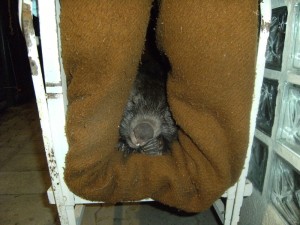
snug as a bug in a rug – Fidel in his “safe” burrow
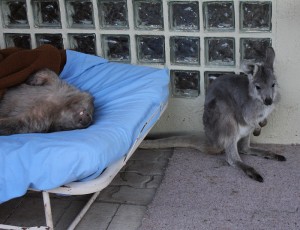
who is my bed?
It’s time to get Britty out in the paddocks grazing day and night. Wallaroos are so different to Greys that I did think for while that she might have a head injury . I have no back round as to why she was in a paddock alone at only 1800 grams. Maybe she had been thrown from the pouch ( macropod mums will do that if they think there is danger ) and landed on her head! The reason for this thinking is that I am not used to seeing a macropod lose balance and do flips and somersaults while running from some sound that is hardly audible or perhaps a shadow of something flapping and the list goes on. I am used to greys who are contented to lounge back in their pouch till about 8kilos and often have to be tipped out.
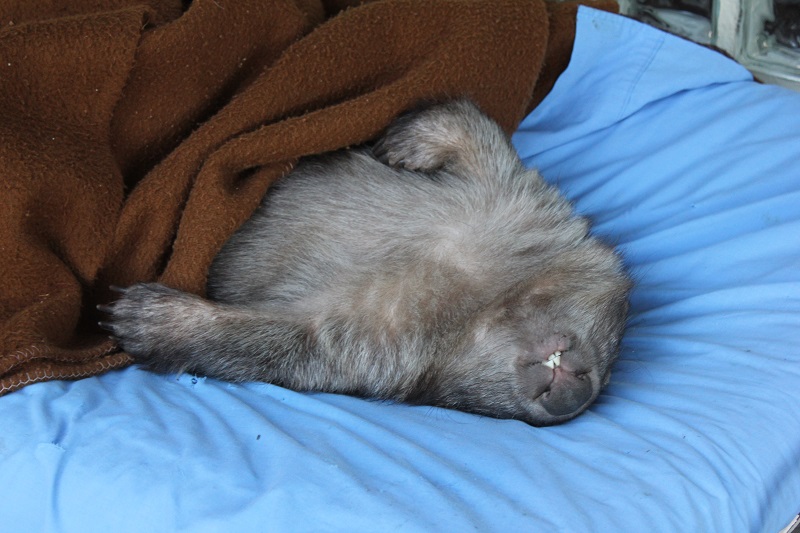
The bed thief – when I went out in the morning this is what I found – wombats obviously rearrange the blankets to their liking
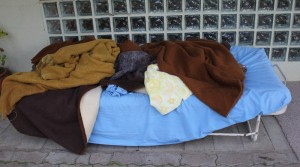
the bed when I left the night before ! Fidel in centre
Once out leap on a couch or on to the bed and settle down for kip. Not so a wallaroo. Wallaroos are out of mums pouch and at heel by 4 kilo . Britty likes to be with me or rather should I say me with her wherever she needs to be grazing. I seem to be spending a lot of time outdoors in the cold! Watching the ones around us at her age they stay close to mum at all times but I think getting close to venturing away.The mums seem to have pouch young and legs and tails can be seen so maybe when these emerge to heel the ones at heel now start venturing off on their own. I suppose I will find out soon. Briity had a gut complaint for about 7 weeks which didn’t stop her from feeding at all but resulting in very sloppy faeces and her not being well.
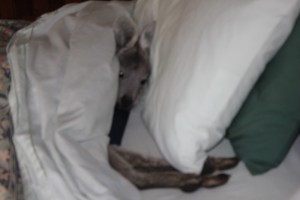
poor Britty very weak, sick in bed
After going through everything I could find to read I decided that this was result of me giving her far to much rich cut grass from town which also held her back from grazing as she loved that grass and also came to expect grass just materialises where you sit and you eat it ,yum,yum. Watching wallaroos it is apparent that eat rough , lots of roots, dirt , old leaves, bark so I thought I probably messed with her gut flora. . Rich cut grass no longer full time on the menu . I got some macropod herbal medicine from a woman who specialises in it, sent to me from Victoria . A treatment for internal thrush, just in case ,and an immune system booster .With that and the use of protexin probiotic and some good grazing hours she seemed somewhat better but the problem still persisted. This problem was very worrying and it was apparent she was not really well .I called the macropod guru, Lynda Staker, in desperation. After weeks of trying many things then talking to Lynda the problem was finally identified .Animal pellets which were recommended in macropod care manuals (and in Lynda’s older manual) were always thought to be O.K. but are now recognised as not so. They are basically carbohydrates and very bad for macropods causing a condition in many called by Lynda “sloppy gut syndrome ” . The pellets are now barred from here ,never to be given to another macropod and all is well. This information regarding pellets is in Lynda’s latest updated manual of 2 volumes! Needless to say I have now updated. Britty is completely recovered ,stacking on weight , now well over 9 kilos , grazing full on and has only some wheaten charf on the veranda, her safe place, which she eats very little of. Wallaroo males are very sturdy and although not as tall as some of the large grey bucks they are very broad chested. The males are a dark grey while females are light grey with yellow tinges around the face and yellowish tails. Males can weigh up to 46.5 kilo while female are much smaller at 25kilo at full adult weight.
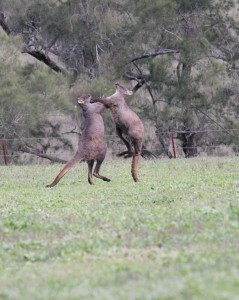
2 large male wallaroos having an afternoon spa
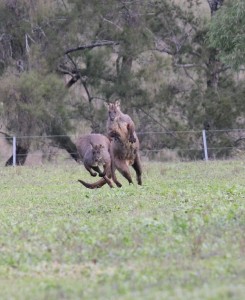
realized they were being watched – took off together!
We had choughs and babblers build nests in the house paddock . We thought there were a few baby choughs in the nest as the screeching for food is worse than a lorikeet .Those of you who have been fortunate or unfortunate to raise an orphaned lorikeet will understand…….. Yesterday morning I noticed a baby had left the nest and was sitting in the tree while an adult near by seemed to be trying to herd it back into the nest . Later in the day while sitting with Britty I saw the little horror heading as fast as it’s legs could go up the paddock and across the road up to the hillside with an adult chasing it making sounds of disapproval and fanning it with wings , to no avail. It can’t fly yet The adult made a call and within a minute the little rouge was surrounded by the family , about 8 adults . We got the bird net and caught the offender who is now in the kangaroo pen .The adults are feeding it and at night we are putting him in a cage for safety . Once he can manage to fly out of the pen he can join the family.
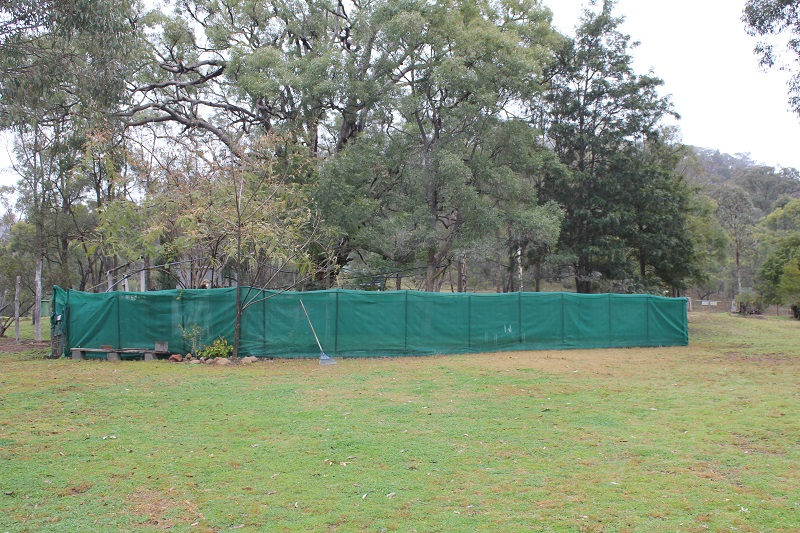
new kangaroo pen which so far has only been used for the rouge chough – the pen has wire fencing with shade cloth on inside and outside
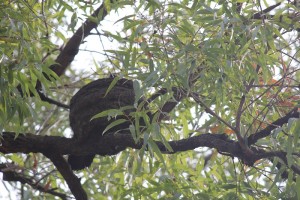
choughs nest – round mud nest
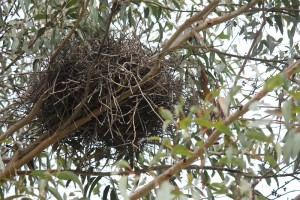
babblers nest – large nest made of twigs
Unfortunately after a couple of days the chough discovered it could climb up the shade cloth which made the adult choughs go crazy trying to keep it under control . We thought we were doing the right thing and put him in a large cage within the enclosure so the adults could feed him through the bars, hoping that it’s tail feathers would be long enough soon for flight. This was going well till I got up one morning and couldn’t hear the usual din going on. I knew something was wrong, no adults around .When I got there I found the young chough dead. Maybe a boobook had tried to get him ( this sometimes happens at the cockatiel aviary) and caused him to have a heart attack , we don’t know what happened .There were no visible marks but I realised I should have put him in a box at night and taken him indoors or maybe just not interfered at all .The choughs have returned so maybe they might use the same nest again .We will let nature take it’s course next time.
The babblers are doing fine , lots of babbling and bathing as the weather has now heated up. Since I began writing this Spring has arrived.
For the past 3 weeks I have been watching the young magpies develop into juvenile birds. Although we had lots of young magpies come into care in Sydney I have never had the privilege of watching them develop daily naturally in the wild. I have really enjoyed this .I love the sound magpies make. It’s lovely to hear their song early in the morning. With Spring here the weather is lovely.early in the morning. While sitting out the front giving Britty her morning bottle my 2 currawong friends “Magnum” and “Mustang” come for their morning grapes, sulphur crested cockatoos, galahs, red rumps ,peaceful doves, wood ducks and more on the front lawn feeding and the magpie song as well all at the same time gives me a wonderful sense of well being. It is at these times when I often think of people that I have loved in my life even though they are no longer alive and feel grateful that they were part of my life and still are in happy memories. With so much misery going on in the world I feel fortunate to experience a sense of wellbeing at times surrounded by nature.
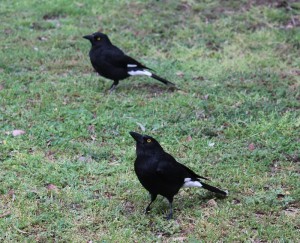
Magnum and Mustang waiting for their morning grapes
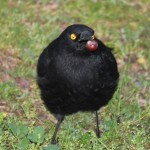
About time, how long do I have to wait for my grape!?
My friend Sandi , bird vet nurse from Sydney finally made it here for a couple of days. It was great to see her and I hope she and partner Jason will come again. We had a beautiful adult tawny frogmouth bought to us a few weeks ago and thanks to Sandi’s lessons on giving injections to birds (when we were in Sydney) we were able to give it the care it needed and released it about a week later . He had collided with a car but fortunately a bird lover was travelling behind and stopped and picked him up. He was gaga for a couple of days and we had to keep him going on fluids but then able to push food into his throat, a mouse at dawn and some heart at dusk and he began to swallow .Adult tawny’s often won’t eat in captivity voluntarily . After about 5 days of eating he was putting on some weight and eyes bright once again so time to go. We took him back to where he was picked up, about 10 ks from here, and off he went.
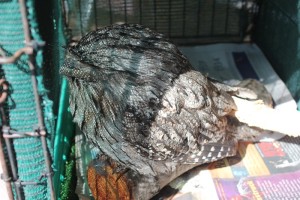
not well – Tawny Frogmouth in care
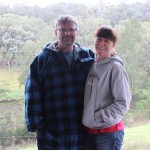
Sandi and Jason
Larry picked up a female wallaroo that been stuck in a ghastly rabbit fence about 8 ks before our place . He has been cutting sections out of bit by bit to make easier access for the wildlife as he found a juvenile wombat stuck in there one day so decided the fence needed some modification and clearly the owners weren’t going to do it .The wallaroo had managed to tug herself free by the time Larry got to her but she had rolled down a gully and was fitting. He picked her up and bought her home. She was registering our presence but was unable to move at all. She had a broken neck and we think some spinal damage as well. She had to be euthanased . She had very small pouch young. A 52gram embryo with his ears still stuck o his head black bulbs for eyes and a small opening in the mouth for the teat. I thought he was probably to small to be viable but he proved me wrong as he was very strong. I had to feed him every 3 hrs and he stabilised after 3 days and was doing O.K. I had him for 5 days. We had to let the fire go out to clean it and I put an electric blanket under his basket . I thought I had the blanket stable on 30%.The right temp is very important with young animals and he needed to be in an enclosure 30-32% maximum. I went to attend to Britty who very sick at the time and it all took longer than I thought it would , took my eye off the temp checking and the temp soared up to 39% .He was dead of course , had completely dehydrated . It was very upsetting, maybe there was a surge as that can happen with solar power. I have always told other people not to overload and then end up doing it myself , it was stupid and careless.
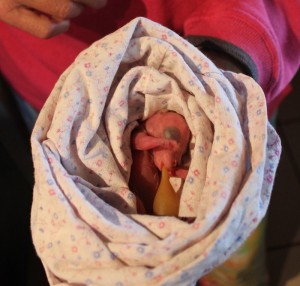
Samson sleeping with his dummy, substitute teat.
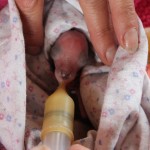
Feeding Samson
My nephew Tim enjoys taking photos and takes some great shots . He lives up North in Wonga .He has family of Kookaburras that visit his backyard and hunt from his back fence. He sent me this shot.
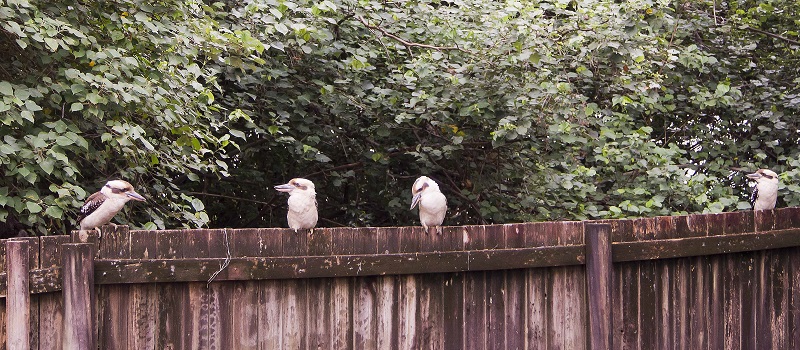
Tim’s visiting Kookaburra family.
Laughing Kookaburra are easy to recognise by plumage and voice. They are off-white below, faintly barred with dark brown, and brown on the back and wings. The tail is broadly barred with black. There is a dark brown eye-stripe through the face. It is one of the larger members of the kingfisher family. In Eastern Qld we get the Blue-winged Kookaburra. The Blue-winged Kookaburra doesn’t have the brown eye-stripe, it has a blue tail and a large amount of blue in the wing, and a pale eye. I can’t tell from the pic which these are. Tim tells me they were very pleased that he was able to give them a good feed of baby rats a couple of days ago as he found a nest in a place that was unwelcome!
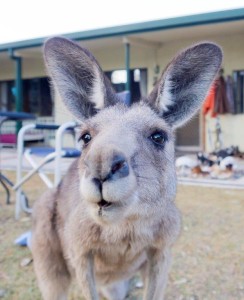
Here’s a shot of Bronte Tim took when he was here.
Fidel’s fur has grown back on his forehead and almost completely on his rump. He is looking good once again. Britty is getting more independent by the day , much to my relief, and now weighs 9700 grams. I have started giving her less milk and I’m sure she will be independent quite soon. She goes off grazing when she feels like it now without worrying to much about where I am.
The cuckoo -shrikes have started arriving so we should see some channel-billed cuckoos and koels soon also.
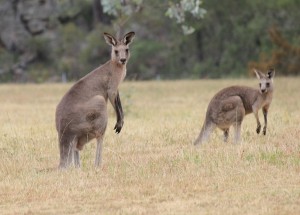
Bozo still about sometimes – with Bobo
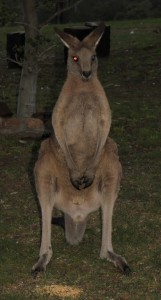
Big Bozo – night visit
We just collected another 260 trees to plant .The majority are Casuarina trees for the Casuarina Cockatoos to munch on in the future we hope. Larry will be busy planting them over the next month.
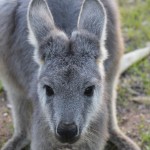
Pretty Britty – well again!
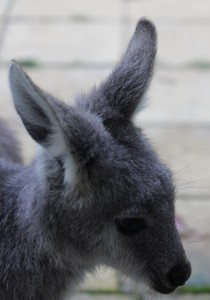
Britty – great profile !
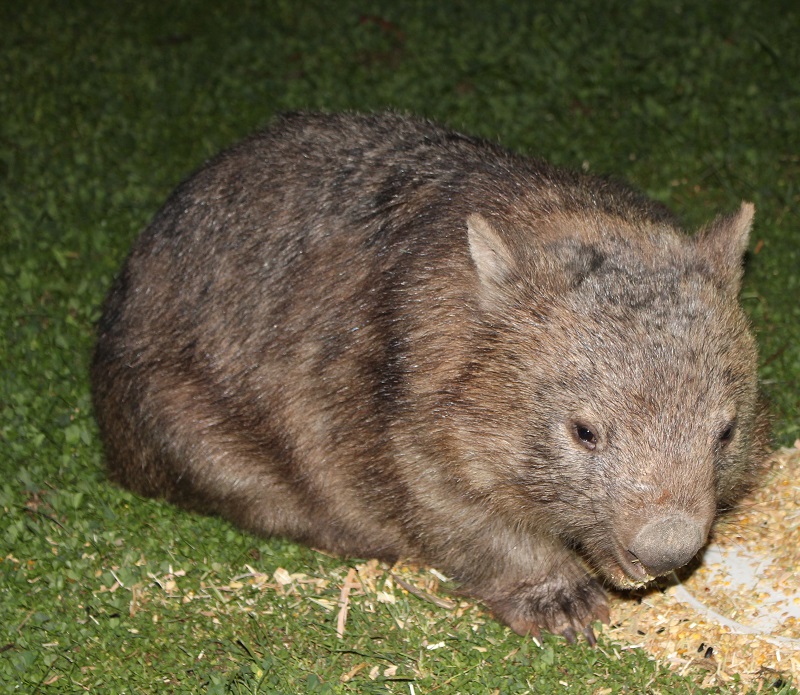
Fidel beautiful again !
